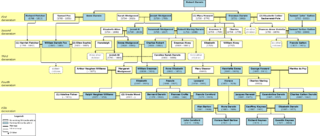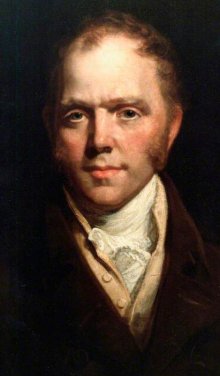
Josiah Wedgwood was an English potter, entrepreneur and abolitionist. Founding the Wedgwood company in 1759, he developed improved pottery bodies by systematic experimentation, and was the leader in the industrialisation of the manufacture of European pottery.

Emma Darwin was an English woman who was the wife and first cousin of Charles Darwin. They were married on 29 January 1839 and were the parents of ten children, seven of whom survived to adulthood.
Wedgwood is a British pottery firm founded by Josiah Wedgwood.

The Darwin–Wedgwood family are members of two connected families, each noted for particular prominent 18th-century figures: Erasmus Darwin, a physician and natural philosopher, and Josiah Wedgwood, a noted potter and founder of the eponymous Wedgwood and Sons pottery company. The Darwin and Wedgwood families were on friendly terms for much of their history and members intermarried, notably Charles Darwin, who married Emma Wedgwood.

Josiah Wedgwood II, the son of the English potter Josiah Wedgwood, continued his father's firm and was a Member of Parliament (MP) for Stoke-upon-Trent from 1832 to 1835. He was an abolitionist, and detested slavery.

Burslem is one of the six towns that along with Hanley, Tunstall, Fenton, Longton and Stoke-upon-Trent form part of the city of Stoke-on-Trent in Staffordshire, England. It is often referred to as the "mother town" of Stoke on Trent.
Maer is a rural village and civil parish in the Borough of Newcastle-under-Lyme, Staffordshire, England, to the west of the pottery manufacturing town of Stoke-on-Trent.

Barlaston is a village and civil parish in the borough of Stafford in the county of Staffordshire, England. It is roughly halfway between the city of Stoke-on-Trent and the small town of Stone. According to the 2001 census the population of the parish was 2,659, rising at the 2011 Census to 2,858.

Etruria Hall in Etruria, Stoke-on-Trent, Staffordshire, England is a Grade II listed house and former home of the potter Josiah Wedgwood. It was built between 1768–1771 by Joseph Pickford. The hall was sold by the Wedgwoods in the 19th century and is now part of a hotel.
John Wedgwood, the eldest son of the potter Josiah Wedgwood, was a partner in the Wedgwood pottery firm 1790–1793 and again 1800–1812.

Wedgwood is an English fine china, porcelain and luxury accessories manufacturer that was founded on 1 May 1759 by the potter and entrepreneur Josiah Wedgwood and was first incorporated in 1895 as Josiah Wedgwood and Sons Ltd. It was rapidly successful and was soon one of the largest manufacturers of Staffordshire pottery, "a firm that has done more to spread the knowledge and enhance the reputation of British ceramic art than any other manufacturer", exporting across Europe as far as Russia, and to the Americas. It was especially successful at producing fine earthenware and stoneware that were accepted as equivalent in quality to porcelain but were considerably cheaper.
The Reverend John Allen Wedgwood, normally known as Allen Wedgwood was rector of Maer Staffordshire.

Barlaston Hall is an English Palladian country house in the village of Barlaston in Staffordshire, on a ridge overlooking the valley of the River Trent to the west, about 5 miles (8.0 km) south of Stoke-on-Trent, with the towns of Stone about 4 miles (6.4 km) to the south, and Stafford about 11 miles (18 km) south.

The Wedgwood Institute is a large red-brick building that stands in Queen Street, in the town of Burslem, Stoke-on-Trent, Staffordshire, England. It is sometimes called the Wedgwood Memorial Institute, but it is not to be confused with the former Wedgwood Memorial College in Barlaston. It achieved listed building status in 1972.

St Mary's Church in the village of Downe, Bromley is the Church of England Parish Church for the parish of Downe. It is a Grade II* listed building, which dates from the 13th century. The church is dedicated to either St Mary the Virgin or St Mary Magdalene.

The North Stafford Hotel is a Grade II* listed hotel in Stoke-on-Trent, Staffordshire, England, opposite the city's railway station, also a Grade II* listed building.

Winton Square in Stoke-on-Trent, Staffordshire, England, houses Stoke-on-Trent railway station, the North Stafford Hotel, and several other historic structures. The square was built in 1848 for the North Staffordshire Railway, whose headquarters were in the station building, and is a significant example of neo-Jacobean architecture. Today, all the buildings and structures in the square are listed buildings and the square is a designated conservation area.
Maer is a civil parish in the district of Newcastle-under-Lyme, Staffordshire, England. It contains 27 buildings that are recorded in the National Heritage List for England. Of these, three are listed at Grade II*, the middle of the three grades, and the others are at Grade II, the lowest grade. The parish contains the villages of Maer and Aston, and the surrounding countryside. Most of the listed buildings are houses, cottages, farmhouses and farm buildings. In the parish is a country house, Maer Hall, and another large house, Lea Head Manor, both of which are listed, together with associated structures. The other listed buildings are a church, memorials in the churchyard, and five mileposts.
Berth Hill is an Iron Age hillfort in Staffordshire, England, about 5 miles (8.0 km) south-west of Newcastle-under-Lyme, and near the village of Maer. It is a scheduled monument. Other forms of its name have been Bryth, Bruff and Burgh Hill.













